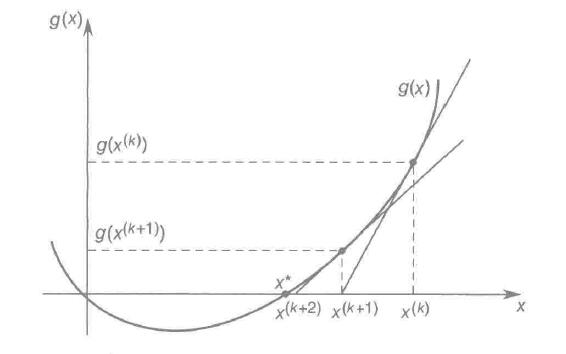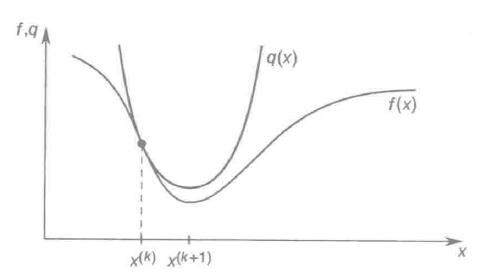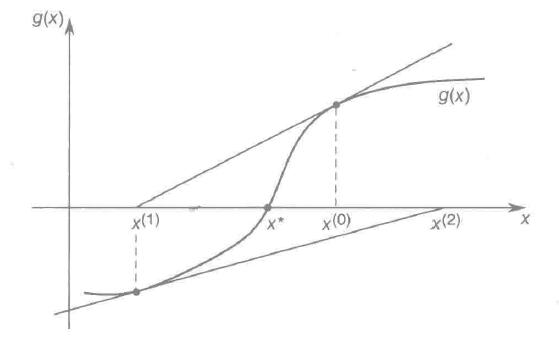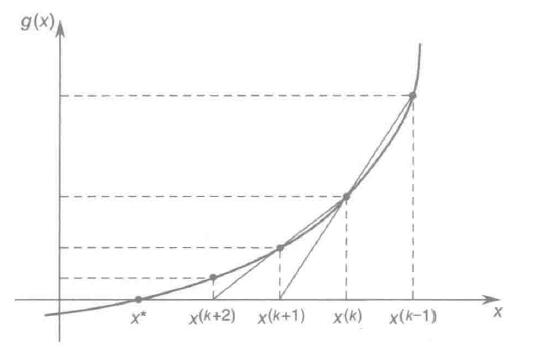数值算法:无约束优化之一维搜索方法之二分法牛顿法割线法
Posted 宏斌PKUCIS
tags:
篇首语:本文由小常识网(cha138.com)小编为大家整理,主要介绍了数值算法:无约束优化之一维搜索方法之二分法牛顿法割线法相关的知识,希望对你有一定的参考价值。
1、二分法(一阶导)
二分法是利用目标函数的一阶导数来连续压缩区间的方法,因此这里除了要求 f 在 [a0,b0] 为单峰函数外,还要去 f(x) 连续可微。
(1)确定初始区间的中点 x(0)=(a0+b0)/2 。然后计算 f(x) 在 x(0) 处的一阶导数 f\'(x(0)), 如果 f\'(x(0)) >0 , 说明极小点位于 x(0) 的左侧,也就是所,极小点所在的区间压缩为[a0,x(0)];反之,如果 f\'(x(0)) <0,说明极小点位于x(0)的右侧,极小点所在的区间压缩为[x(0),b0];如果f\'(x(0)) = 0,说明就是函数 f(x) 的极小点。
(2)根据新的区间构造x(1),以此来推,直到f\'(x(k)) = 0,停止。
可见经过N步迭代之后,整个区间的总压缩比为(1/2)N,这比黄金分割法和斐波那契数列法的总压缩比要小。
1 #ifndef _BINARYSECTION_H_ 2 #define _BINARYSECTION_H_ 3 4 typedef float (* PtrOneVarFunc)(float x); 5 void BinarySectionMethod(float a, float b, PtrOneVarFunc fi, float epsilon); 6 7 #endif
1 #include<iostream> 2 #include<cmath> 3 #include "BinarySection.h" 4 5 using namespace std; 6 7 void BinarySectionMethod(float a, float b, PtrOneVarFunc tangent, float epsilon) 8 { 9 float a0,b0,middle; 10 int k; 11 k = 1; 12 a0 = a; 13 b0 = b; 14 middle = ( a0 + b0 )/2; 15 16 while( abs(tangent(middle)) - epsilon > 0 ) 17 { 18 #ifdef _DEBUG 19 cout<<k++<<"th iteration:x="<<middle<<",f\'("<<middle<<")="<<tangent(middle)<<endl; 20 #endif 21 22 if( tangent(middle) > 0) 23 { 24 b0 = middle; 25 } 26 else 27 { 28 a0 = middle; 29 } 30 middle =( a0+b0)/2; 31 } 32 33 cout<<k<<"th iteration:x="<<middle<<",f\'("<<middle<<")="<<tangent(middle)<<endl; 34 }
1 #include<iostream> 2 #include "BinarySection.h" 3 4 5 float TangentFunctionofOneVariable(float x) 6 { 7 return 14*x-5;//7*x*x-5*x+2; 8 } 9 10 int main() 11 { 12 BinarySectionMethod(-50, 50, TangentFunctionofOneVariable, 0.001); 13 return 0; 14 }
1th iteration:x=0,f\'(0)=-5 2th iteration:x=25,f\'(25)=345 3th iteration:x=12.5,f\'(12.5)=170 4th iteration:x=6.25,f\'(6.25)=82.5 5th iteration:x=3.125,f\'(3.125)=38.75 6th iteration:x=1.5625,f\'(1.5625)=16.875 7th iteration:x=0.78125,f\'(0.78125)=5.9375 8th iteration:x=0.390625,f\'(0.390625)=0.46875 9th iteration:x=0.195312,f\'(0.195312)=-2.26562 10th iteration:x=0.292969,f\'(0.292969)=-0.898438 11th iteration:x=0.341797,f\'(0.341797)=-0.214844 12th iteration:x=0.366211,f\'(0.366211)=0.126953 13th iteration:x=0.354004,f\'(0.354004)=-0.0439453 14th iteration:x=0.360107,f\'(0.360107)=0.0415039 15th iteration:x=0.357056,f\'(0.357056)=-0.0012207 16th iteration:x=0.358582,f\'(0.358582)=0.0201416 17th iteration:x=0.357819,f\'(0.357819)=0.00946045 18th iteration:x=0.357437,f\'(0.357437)=0.00411987 19th iteration:x=0.357246,f\'(0.357246)=0.00144958 20th iteration:x=0.357151,f\'(0.357151)=0.000114441
2、牛顿法(二阶导)
前提:f 在 [a0,b0] 为单峰函数, 且[a0,b0] 在极小点附近,不能离的太远否则可能无法收敛。
这里进一步要求f(x)连续二阶可微。对于函数 f(x) 上一点 x(k),我们可以使用泰勒公式构造一个多项式函数 q(x)=f(x(k))+f\'(x(k))(x-x(k))+1/2 * f\'\'(x(k))(x-x(k))2,对 f(x)在 x(k) 附近进行局部二次拟合,q(x)可以看为f(x)的(在x(k)附近的局部)近似(当f(x)为二次函数时,q(x)=f(x)),因此求f(x)的极小点可以转化为求q(x)的极小点。
0=q\'(x)=f\'(x(k))+f\'\'(x(k))(x-x(k)) => x = x(k) - f\'(x(k))/f\'\'(x(k)) 因此可以选择 x(k+1) = x(k) - f\'(x(k))/f\'\'(x(k))
牛顿法能够不断地迫使目标函数f(x)的一阶导数趋于0。x(k+1)由g(x(k))的切线产生:

x(k+1)为g(x(k))的切线与x轴交点。随着x(k) -> x*, g(x)->0。(g(x)为f(x)的近似)
注意1:牛顿法不需要计算函数值,但需要计算一阶导数和二阶导数值,且要求 f\'\'(x)>0,如果f\'\'(x)<0,则可能存在从 x(k) 到 x(k+1)反向调整,收敛到极大点,即越来越偏离极小点。

f\'\'(x(k))>0, x(k)->x*

f\'\'(x(k))<0, x(k)远离x*
注意2:如果初始x(k)的调整幅度太大可能会导致x的调整序列在极小点左右波动。

初始点g\'(x(0))/g\'\'(x(0))太大,造成算法失效
1 #ifndef _NEWTON_H_ 2 #define _NEWTON_H_ 3 4 #define NEWTON_ZERO 0.0001 5 6 typedef float (* PtrOneVarFunc)(float x); 7 8 9 10 void NewtonMethod(float x0, PtrOneVarFunc oneorderderivative, PtrOneVarFunc twoorderderivative, float epsilon); 11 12 13 #endif
1 #include<iostream> 2 #include<cmath> 3 #include "Newton.h" 4 5 using namespace std; 6 7 void NewtonMethod(float x0, PtrOneVarFunc oneorderderivative, PtrOneVarFunc twoorderderivative, float epsilon) 8 { 9 float xk,newtonstep; 10 int k; 11 k = 0; 12 xk = x0; 13 14 while( abs(oneorderderivative(xk)) - epsilon > 0) 15 { 16 17 #ifdef _DEBUG 18 cout<<k<<"th iteration xk="<<xk<<",f\'("<<xk<<")="<<oneorderderivative(xk)<<endl; 19 #endif 20 k++; 21 22 newtonstep = twoorderderivative(xk); 23 if(abs(newtonstep) - NEWTON_ZERO < 0) 24 { 25 cout<<"f\'\'("<<xk<<")=0, algorithms terminate!"<<endl; 26 return ; 27 } 28 29 newtonstep = oneorderderivative(xk) / newtonstep; 30 xk = xk - newtonstep; 31 } 32 33 cout<<k<<"th iteration xk="<<xk<<",f\'("<<xk<<")="<<oneorderderivative(xk)<<endl; 34 }
#include<iostream> #include "Newton.h" float OneOrderDerivative(float x) { return (14*x-5);//f(x)=7*x*x-5*x+2; } float TwoOrderDerivative(float x) { return 14;//f\'\'(x)=14; } int main() { NewtonMethod(-109.23, OneOrderDerivative, TwoOrderDerivative, 0.001); return 0; }
0th iteration xk=-109.23,f\'(-109.23)=-1534.22 1th iteration xk=0.35714,f\'(0.35714)=-4.57764e-05
(3)割线法
前提:f 在 [a0,b0] 为单峰函数, 且[a0,b0] 在极小点附近,不能离的太远否则可能无法收敛。
牛顿法需要f(x)的二阶导数,如果二阶导数不存在,可以采用不同点的一阶导数对其近似,如 f\'\'(x(k))=(f\'(x(k))-f\'(x(k-1)))/(x(k)-x(k-1)),将其带入牛顿迭代公式,可以得到新的迭代公式:
x(k+1) = x(k) - f\'(x(k)) * (x(k)-x(k-1)) /(f\'(x(k))-f\'(x(k-1))) <=> x(k+1) = ( f\'(x(k))x(k-1) - f\'(x(k-1)) x(k) ) / ( f\'(x(k)) - f\'(x(k-1)) )
这个方法需要两个初始点 x(-1)和x(0),可以看出割线法不需要计算函数值f(x(k)),二阶导数值f\'\'(x(k)),它使用x(k)和x(k-1)之间的割线产生x(k+1):

x(k+1)由过x(k)和x(k-1)的割线产生
1 #ifndef _SECANT_H_ 2 #define _SECANT_H_ 3 4 #define SECANT_ZERO 0.1 5 6 typedef float (* PtrOneVarFunc)(float x); 7 8 9 10 void SecantMethod(float x0, float x_1, PtrOneVarFunc oneorderderivative, float epsilon); 11 12 13 #endif
1 #include<iostream> 2 #include<cmath> 3 #include "Secant.h" 4 5 using namespace std; 6 7 void SecantMethod(float x_1, float x0, PtrOneVarFunc oneorderderivative, float epsilon) 8 { 9 float xk,xk_1,t1,t_1,tk; 10 int k; 11 k = 0; 12 xk = x0; 13 xk_1 = x_1; 14 15 if(xk - xk_1 < SECANT_ZERO) 16 { 17 cout<<"x0 == x_1,algorithm terminate."<<endl; 18 return; 19 } 20 21 while( abs(oneorderderivative(xk)) - epsilon > 0) 22 { 23 #ifdef _DEBUG 24 cout<<k<<"th iteration xk_1="<<xk_1<<",f\'("<<xk_1<<")="<<oneorderderivative(xk_1)<<",xk="<<xk<<",f\'("<<xk<<")="<<oneorderderivative(xk)<<endl; 25 #endif 26 27 k++; 28 29 t1 = oneorderderivative(xk); 30 t_1 = oneorderderivative(xk_1); 31 32 tk = xk; 33 xk = (t1*xk_1 - t_1*xk)/(t1-t_1); 34 xk_1 = tk; 35 } 36 37 cout<<k<<"th iteration xk_1="<<xk_1<<",f\'("<<xk_1<<")="<<oneorderderivative(xk_1)<<",xk="<<xk<<",f\'("<<xk<<")="<<oneorderderivative(xk)<<endl; 38 39 }
1 #include<iostream> 2 #include "Secant.h" 3 4 5 float OneOrderDerivative(float x) 6 { 7 return (14*x-5);//f(x)=7*x*x-5*x+2; 8 } 9 10 11 int main() 12 { 13 SecantMethod(-109.23, -20, OneOrderDerivative, 0.001); 14 return 0; 15 }
0th iteration xk_1=-109.23,f\'(-109.23)=-1534.22,xk=-20,f\'(-20)=-285 1th iteration xk_1=-20,f\'(-20)=-285,xk=0.357142,f\'(0.357142)=-1.03116e-05
(4)拟抛物线插值法
迭代算法跟割线法类似,不同点为使用三个点的函数值近似公式中的两个一阶导数。
以上是关于数值算法:无约束优化之一维搜索方法之二分法牛顿法割线法的主要内容,如果未能解决你的问题,请参考以下文章